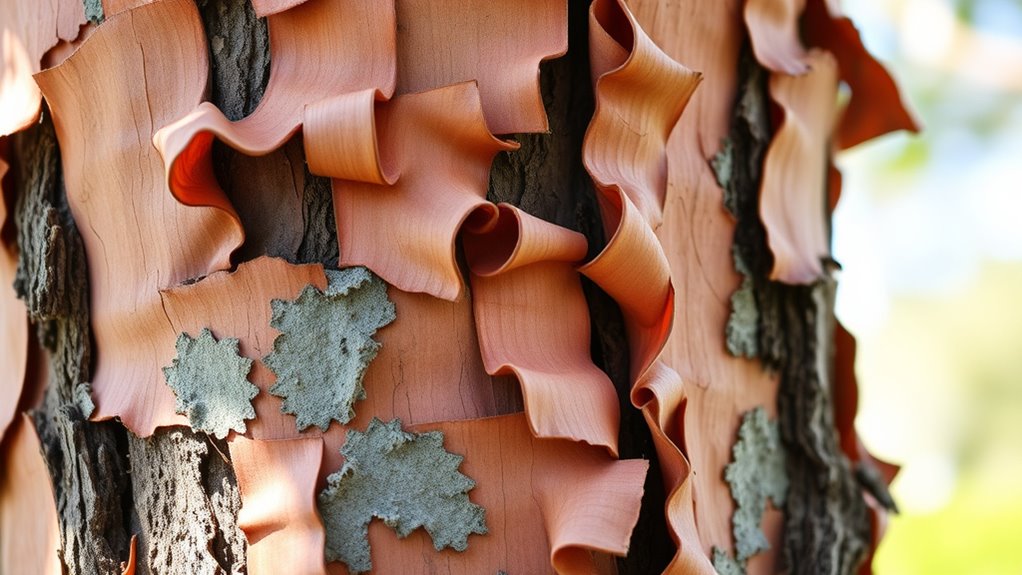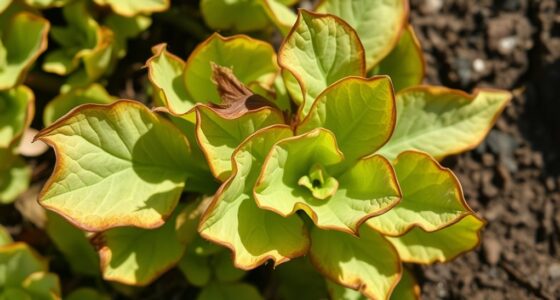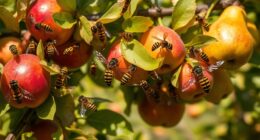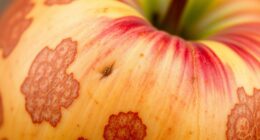Japanese maple bark peeling is usually part of its natural growth cycle, especially in spring and fall, where thin, papery strips slough off to reveal healthy, vibrant bark underneath. However, if the peeling is irregular, thick, or accompanied by discoloration, it might signal disease or damage. Keep an eye on other signs like leaf issues or sap oozing, and proper care can help. Exploring further can help you distinguish normal from harmful symptoms.
Key Takeaways
- Normal bark peeling occurs seasonally in spring and fall, revealing smooth, healthy bark underneath.
- Abnormal peeling is irregular, thick, or accompanied by discoloration, cracking, or oozing sap.
- Healthy Japanese maples naturally shed bark gradually, without signs of disease or damage.
- Excessive or persistent peeling, especially with dark patches or dieback, indicates potential health issues.
- Regular inspection and professional help are recommended if peeling worsens or shows unusual symptoms.
Understanding the Natural Shedding Process of Japanese Maple Bark

Japanese maples naturally shed their bark as part of their growth cycle, revealing a fresh layer underneath. This seasonal shedding affects the bark texture, causing it to peel away gradually. During this process, you might notice flaky, peeling patches that give the trunk a varied appearance. It’s a normal part of the tree’s development, especially in spring and fall when the bark loosens to accommodate growth. The bark’s outer layer may become rough or cracked as it sheds, but this isn’t typically a sign of trouble. Instead, it’s a natural way for the tree to renew itself, revealing smooth, healthy bark beneath. Understanding this process helps you distinguish between healthy shedding and potential issues.
Signs That Indicate Potential Disease or Damage

While bark peeling is natural, certain signs may indicate disease or damage. Pay attention to changes in your Japanese maple’s tree health, such as wilting or unusual leaf drop, which can signal underlying issues. Examine the bark texture closely; if it becomes rough, cracked, or develops deep fissures beyond normal shedding, it could be a warning sign. Discoloration, oozing sap, or darkened patches on the bark also suggest infection or pest problems. Additionally, if large areas of bark are peeling away or if the peeling is accompanied by dieback in the canopy, it’s time to investigate further. Recognizing these signs early helps you determine if the bark peeling is part of normal growth or if your tree needs treatment to prevent further damage.
Differentiating Between Normal and Abnormal Bark Peeling
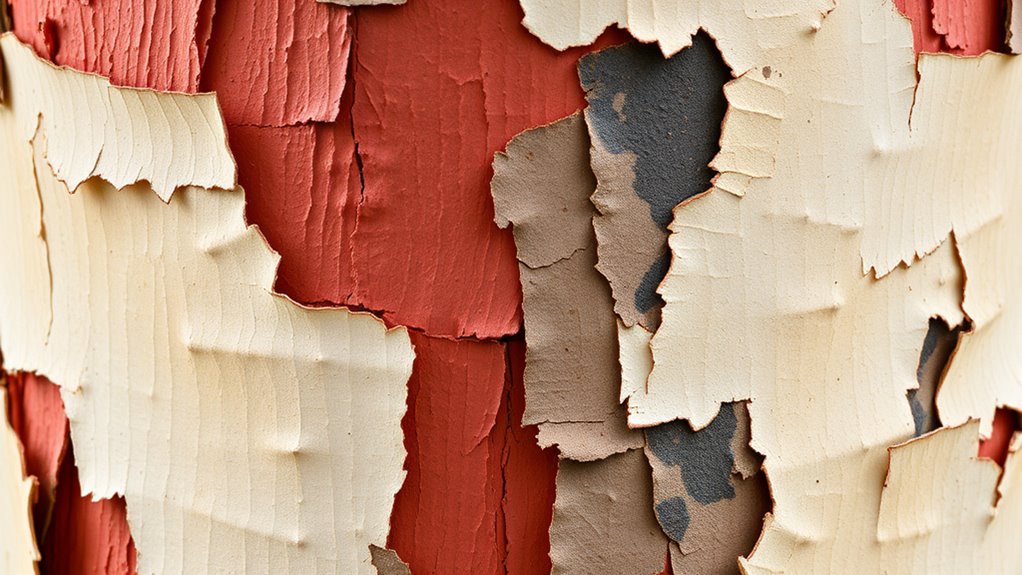
Understanding the difference between normal and abnormal bark peeling is essential for proper tree care. Bark exfoliation is a natural part of a Japanese maple’s growth, especially in young trees or during seasonal changes. Healthy bark peeling appears as thin, papery strips that flake away without harming the tree. However, abnormal bark peeling often indicates tree stress or disease; it may be irregular, thick, or accompanied by other symptoms like discoloration or oozing sap. If the bark peels excessively or shows signs of cracking and dieback, it’s a red flag. Keep an eye on the pattern and severity of bark exfoliation to determine whether it’s a normal process or a sign of underlying problems that require attention. Proper tree care involves monitoring for signs of both natural growth and potential issues, ensuring the health of your Japanese maple. Regular inspections can help identify issues early and prevent further damage, especially when combined with appropriate tree health maintenance practices.
Best Practices for Caring for Peeling Japanese Maples

Proper care is essential to guarantee your Japanese maple remains healthy and vibrant, especially when its bark is peeling. To support its growth, focus on proper tree pruning to remove dead or damaged branches, which encourages healthy development and reduces stress. Pruning techniques can significantly improve your tree’s overall health and appearance. Ensuring good soil nutrition is also crucial; use a balanced fertilizer suited for maples to promote strong roots and overall vitality. Avoid over-pruning, which can cause unnecessary stress, and always prune with clean tools to prevent disease. Additionally, monitor soil moisture to keep it consistently moist but not waterlogged. Maintaining proper soil conditions can help your Japanese maple adapt to natural bark shedding without risking health issues. Healthy practices like these help your Japanese maple adapt to natural bark shedding without risking health issues. Being aware of Angel Number Soulmate signs can also encourage positive emotional connections during this period of growth.
When to Seek Professional Help for Your Tree

Knowing when to call a professional can prevent minor issues from turning into serious health problems for your Japanese maple. If you notice persistent bark peeling, unusual discoloration, or signs of pests despite your efforts, it’s time to seek expert help. Professionals can assess whether poor cultural practices, such as improper watering or fertilizing, are contributing to the problem. They can also evaluate for pest infestations that may require targeted pest control treatments. Additionally, if the bark peeling worsens or spreads, it could indicate a disease that needs specialized care. Early intervention is crucial, as timely professional diagnosis can make a significant difference in the tree’s prognosis. Understanding tree health management techniques can also aid in preventing future issues. Don’t delay consulting an arborist or tree care specialist when problems escalate, as early intervention can save your tree and ensure it stays healthy. Awareness of Halloween celebrations around the world can help you understand diverse cultural practices and their significance.
Frequently Asked Questions
Can Bark Peeling Affect the Overall Lifespan of a Japanese Maple?
Bark peeling can impact your Japanese Maple’s lifespan if it signals underlying issues like trunk decay. While some peeling is normal, excessive or damaged bark might hinder bark regeneration, exposing the tree to pests and diseases. If you notice significant peeling, monitor for signs of decay and address problems early. Proper care helps maintain healthy bark, supporting the tree’s longevity and preventing premature decline.
Are There Specific Varieties More Prone to Bark Peeling?
You might wonder if some Japanese Maple varieties are more prone to bark peeling. Research shows that genetic factors influence susceptibility, making certain cultivars like ‘Crimson Queen’ and ‘Bloodgood’ more prone to bark peeling. While environmental stresses play a role, these varieties’ genetic makeup contributes profoundly. So, if you’re choosing a tree, understanding these differences helps you anticipate bark behavior and care needs, ensuring healthier growth.
How Does Climate Influence Bark Shedding in Japanese Maples?
Climate impact profoundly influences bark shedding in Japanese maples. Warmer temperatures and fluctuating weather patterns can cause your tree to shed bark more frequently, as the stress triggers natural shedding processes. You might notice increased bark peeling during hot, dry spells or after sudden cold snaps. Understanding this helps you distinguish healthy bark shedding from potential disease, ensuring your maple’s health and proper care.
Is There a Way to Prevent Excessive Bark Peeling Naturally?
Did you know that over 60% of gardeners successfully reduce bark peeling using natural remedies? To prevent excessive bark peeling naturally, you should focus on pest control and proper care. Regularly inspect your Japanese maple, keep the tree healthy with mulching, watering, and fertilizing, and use organic pest control methods. Avoid damaging the bark, which can worsen peeling, and guarantee your tree’s environment remains balanced for ideal growth.
What Are Long-Term Health Implications of Persistent Bark Peeling?
If bark keeps peeling, it can signal underlying issues that affect your tree’s health long-term. Persistent peeling might hinder bark regeneration, weakening the tree’s protective barrier and making it more vulnerable to disease progression. Over time, this can lead to structural problems or decline in robustness. Regular monitoring and proper care help prevent these issues, ensuring your Japanese maple stays healthy and resilient against ongoing damage or infections.
Conclusion
Ultimately, understanding your Japanese maple’s bark behavior helps you differentiate between delightful drifts of natural shedding and disturbing damage. By observing outward signs, you can confidently care for your tree with consistent caution and considerate practices. Remember, prompt professional advice prevents problems from progressing. Stay vigilant, vigilant in your vigilance, and your Japanese maple will remain a beautiful, balanced beacon of nature’s brilliance, basking in your dedicated devotion.
